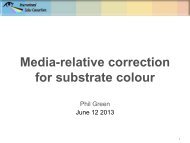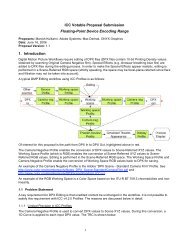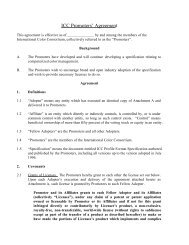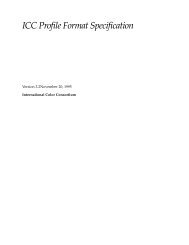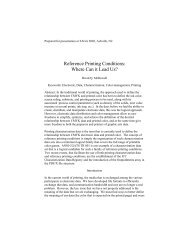Using the sRGB v4 ICC appearance profile
Using the sRGB v4 ICC appearance profile
Using the sRGB v4 ICC appearance profile
You also want an ePaper? Increase the reach of your titles
YUMPU automatically turns print PDFs into web optimized ePapers that Google loves.
As many elements are used in <strong>the</strong> designing process to realize pleasing<br />
reproduction, many color reproductions exist 3<br />
. There are two main aims:<br />
re-targeting when <strong>the</strong> second visualization is intended to represent or match <strong>the</strong><br />
original first visualization,<br />
re-purposing when <strong>the</strong> second visualization is independent of (not constrained<br />
by) <strong>the</strong> first visualization and can be optimized for <strong>the</strong> second visualization<br />
condition.<br />
The goal of <strong>the</strong> Appearance Profile is to provide a ‘Consistent colour <strong>appearance</strong>'<br />
between <strong>the</strong> image displayed on <strong>the</strong> monitor (original first visualization) and <strong>the</strong><br />
printed output (second visualization). Consistent colour <strong>appearance</strong> aims to<br />
achieve a consistent reproduction for <strong>the</strong> two visualizations by matching color and<br />
color tone for <strong>the</strong> entire area.<br />
The ‘Consistent colour <strong>appearance</strong>’ reproduction objective is most useful when<br />
users wish to be able to:<br />
• Retouching <strong>the</strong> image on <strong>the</strong> display monitor.<br />
• Produce printed outputs that have a similar look even when printed from<br />
different types of printing devices.<br />
• Print or view an image that looks similar to <strong>the</strong> image obtained by image<br />
capture or a scanning device.<br />
General recommendations<br />
In <strong>the</strong> following, three <strong>profile</strong> use cases are described as examples of color rerendering<br />
processing of color rendered images. For each case it is specified which<br />
<strong>profile</strong> and which rendering intent is recommended. The three cases are shown in<br />
figure 1.<br />
Case 1: where an image is intended to be reproduced for viewing in conditions that<br />
are very different from that of <strong>the</strong> input, <strong>the</strong> re-purposing perceptual intent should<br />
be selected.<br />
When <strong>the</strong> input image is optimal and is desired to be reproduced under o<strong>the</strong>r<br />
viewing conditions <strong>the</strong> following applies:<br />
Case 2: when <strong>the</strong> difference between source gamut and destination gamut is small,<br />
colormetric intent is used.<br />
Case 3: when <strong>the</strong> difference between source gamut and destination gamut is large,<br />
‘Colour Appearance’ perceptual intent is used.<br />
3 According to [Note: #2, Page 5]





